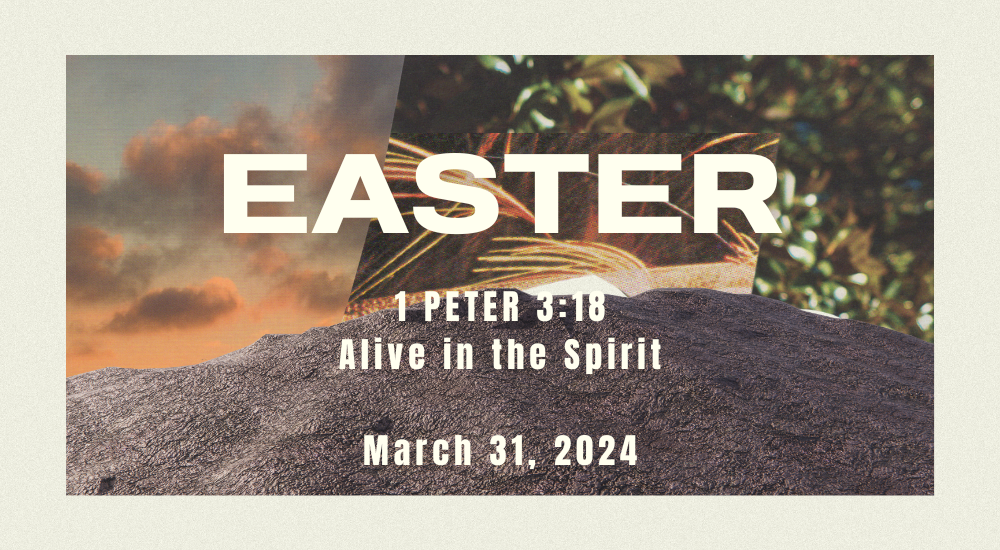
In the Bible our Lord’s death is prophetically anticipated, for all through the Old Testament there are references to the coming of the Messiah and that He would die. For example, Genesis 3:15; Exodus 12:13; Isaiah 53:5-6. Our Lord’s death is also historically stated in the Word of God. In the four Gospels, over two hundred verses are taken up with a detailed account of the sufferings and death of our Savior. The death of Christ is also doctrinally explained in the Scriptures: Isaiah 53:5; 2 Corinthians 5:21. For what purpose? To live!
1 Peter 3:18: “For Christ also suffered once for sins, the righteous for the unrighteous, that he might bring us to God, being put to death in the flesh but made alive in the spirit”
- Grammatical Usage: “made alive” or in the Greek, “zóopoieó” meaning, “springing up; quickened”; “spirit” or “pneuma” meaning, “wind; breath” i.e., the Holy Spirit
- Literal Interpretation: Because even the Messiah, without sin, once for all suffered in our behalf, a just man for unjust people, in order (and with the result) that He might bring us to God. Although He was in fact put to death in the flesh, yet He was made alive by the Spirit.
- Contextual/Comparison: God keeps His Word, God continually uses His Word. In 1 Peter 3:18 we have a key verse regarding the explanation of our Lord’s death and resurrection, underscoring three truths:
- THE SOLEMN FACT OF HIS DEATH
This is indicated in the words “Christ hath suffered…being put to death in the flesh.” He really did die!
- He was born to die and there was nothing accidental about His death (2 Corinthians 5:21).
- There was a divine necessity about His death (John 3:14).
- The place of His death was at Calvary, outside Jerusalem;
- The manner of His death was by crucifixion. Notice our key verse says, “He was put to death” – this indicates deliberate violence. Every kind of wound known to medical science was inflicted on His body; the crown of thorns was put on His head, He was smitten with a rod, and a spear was thrust into His side. He was flogged and nails pierced His hands and feet.
- He bore all this voluntarily for us (John 10:18)
- The spiritual and mental anguish that He bore was greater than any physical pain.
- THE UNIQUE NATURE OF HIS DEATH
Notice the words “Christ died for sins once…the righteous for the unrighteous.” In using the word ‘unique’ we mean that His death was different from any other before or since. People die from old age, from disease, from accident, by suicide or as martyrs. Why did Jesus die? Not for any of these reasons.
- It was a sinless death. He was the “righteous” One, holy and sinless. His enemies and friends said so. There was no cause of death in Himself; yet He died, and therefore His death was unique in that it was for a purpose.
- It was a sacrificial death – for sins. Why was a sacrifice necessary? – because of your sin and mine. Why were the Old Testament sacrifices offered? Because of sin – and all these sacrifices culminated in the offering of our Lord Jesus Christ (John 1:29). This was the only way in which salvation could be offered to men and women (Hebrews 9:22; 25-26).
- It was a substitutionary death. He died “the righteous for the unrighteous”, and the word ‘for’ means ‘in the place of’. He died in my place, in your place – look up Isaiah 53:5 and alter the word “our” to “my”. The innocent One took the place of the guilty one – that is the meaning of substitution and because He died you and I live.
- It was a sufficient death. “For Christ died for sins once for all, the righteous for the unrighteous…” His offering upon the Cross was complete and final; His work was finished (Hebrews 1:3; 10:9-14).
- THE GLORIOUS RESULT OF HIS DEATH
Jesus died to deal with our sin and to remove the barrier of our sin. But see how this is stated in our key verse: “For Christ died for sins once for all…to bring you to God.” In other words, the Lord Jesus died to reconcile us to God, to restore us into fellowship with God, the fellowship that had been lost through our sin.
- When He died on the Cross He cried out triumphantly, “It is finished!” – referring to the fact that His work of atonement was now completed. Then what happened?
- We are told in Matthew 27:51 that “the curtain of the temple was torn in two from top to bottom”, indicating that the way was now open into the holiest place (Hebrews 10:19-22). We can see the wonderful work that Jesus did on the Cross, and how great our salvation is! But where is the evidence that His death really accomplished all this?
- Look at the last five words in our key verse – “made alive by the Spirit.” This refers to the resurrection of the Lord Jesus, who not only died for our sins and suffered in our place, bearing the punishment that was due to us, but He was “raised to life for our justification” (Romans 4:25).
- This is the pledge that God gave that His work on the Cross was acceptable to Him and sufficient for our salvation.
- Thank God He was “made alive by the Spirit” and that He is now risen, exalted, reigning and coming soon for His own.
- Conclusion: Have I been made alive by the Spirit?
